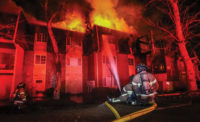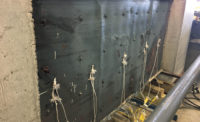With load tests still underway to improve the performance-based design of a cutting-edge office-tower core wall, researchers at Purdue University are gearing up to do a related study: fire tests to determine the fire performance of the wall’s coupled steel-plate modules filled with rebar-free concrete.
And in another step forward for the first use of the shear-wall system—intended to speed construction—the Seattle buildings department has approved a request for sprayed-on fire resistance on only the outer surface of the core of the 850-ft-tall Rainier Square Tower.
“The argument is that inside the core, around the elevator hoist way, there is mostly no fire load,” said Ron Klemencic, chairman and CEO of Magnusson Klemencic Associates (MKA), at the 2018 North American Steel Construction Conference held April 11-13 in Baltimore by the American Institute of Steel Construction (AISC).
MKA is the pioneer of the office-tower application of the wall system and Rainier Square’s engineer. “The approval will save the owner $1 million,” added Klemencic, who is also the catalyst for the ongoing research on the modules.
The proposed fire test project, called performance-based structural fire engineering of concrete-filled composite plate shear walls, is expected to provide physical proof of the system’s fire resistance.
That may eliminate applied fire resistance and make approvals easier, said Klemencic, also a director of the Charles Pankow Foundation, the sponsor of the research.
The goal of the fire tests is to develop code change proposals for the AISC Specification 360-XX, Appendix 4-Fire Design. These will include structural performance-based design methodologies and standard fire ratings for the core walls and floor-to-wall connections, according to Amit H. Varma, director of the Robert L. and Terry L. Bowen Laboratory at Purdue, principal investigator for the proposed fire tests and co-principal investigator, with Michel Bruneau at the University at Buffalo, for the load tests.
The fire tests, which will reuse shortened versions of the six module specimens from the load tests, are expected to take 18 months and cost $160,000. A design tool is one of the deliverables, said Varma at the steel conference, which drew a record 5,175 registrants.
The Purdue-Buffalo load tests are co-funded by $600,000 from Pankow and AISC. All Pankow and AISC research products are available free of charge.
Purdue tests on five of six specimens are complete. The performance of the assemblies under a range of axial loads is equal to or better than predicted. Consequently, “confidence in the core-wall system has grown further,” said Klemencic.
The tests also demonstrate directly the influence of cross-tie spacing, opening the door for wider spacing if loading conditions permit, added Varma.
The sixth module will be tested this summer at Purdue. The focus will be on a first-ever wind-loading protocol. The test will shed light on stiffness degradation and high-cycle, low-amplitude fatigue behavior.
All of the Purdue test specimens are 9 ft tall and 3 ft long. Wall thickness is 9 in. and both web- and flange-plate thickness are 3⁄16 in.
Four parameters are varied: axial load level, plate slenderness ratio, tie bar diameter and spacing, and use of shear studs with the ties.
The second part of the load tests, on C-shaped-in-plan specimens, will begin this summer at the University at Buffalo. The tests are focused on understanding the behavior of the C-shapes under shifting neutral-axis locations.
The Purdue-Buffalo research team expects to publish the system’s performance-based design guide next year.
A related Pankow project, also led by Varma and Bruneau, involves implementing the FEMA P-695 process for evaluating seismic performance of core-wall systems designed for high seismic regions.
The work involves selecting and designing several archetype building structures using the core-wall system. The test also develops and benchmarks numerical models for simulating the seismic response of the system and conducts numerical simulations to evaluate dynamic responses of the structures to increasing seismic ground-motion intensities. Researchers will use the results to propose “R” factors for the seismic design of the composite core-wall systems.
Formally referred to as the response modification coefficient, the R factor accounts for the ductility of the building and, accordingly, adjusts the lateral loads used for design.
The P-695 study is required for the structural design standard—the American Society of Civil Engineers’ ASCE 7—to allow a system’s use within the prescriptive requirements of the standard. “This will allow the composite core-wall system to go mainstream,” says Klemencic.
The hoped-for schedule for the Purdue fire tests, currently in the formative stage, is to have a research plan and funding by the fall. Analytical work would then begin. If all goes well, fire testing would start next spring.






Post a comment to this article
Report Abusive Comment